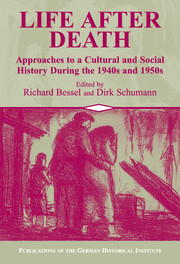Book contents
- Frontmatter
- Introduction Violence, Normality, and the Construction of Postwar Europe
- 1 Post-Traumatic Stress Disorder and World War II
- 2 Between Pain and Silence
- 3 Paths of Normalization after the Persecution of the Jews
- 4 Trauma, Memory, and Motherhood
- 5 Memory and the Narrative of Rape in Budapest and Vienna in 1945
- 6 “Going Home”
- 7 Desperately Seeking Normality
- 8 Family Life and “Normality” in Postwar British Culture
- 9 Continuities and Discontinuities of Consumer Mentality in West Germany in the 1950s
- 10 “Strengthened and Purified Through Ordeal by Fire”
- 11 The Nationalization of Victimhood
- 12 Italy after Fascism
- 13 The Politics of Post-Fascist Aesthetics
- 14 Dissonance, Normality, and the Historical Method
- Index
4 - Trauma, Memory, and Motherhood
Germans and Jewish Displaced Persons in Post-Nazi Germany, 1945-1949
Published online by Cambridge University Press: 05 January 2013
- Frontmatter
- Introduction Violence, Normality, and the Construction of Postwar Europe
- 1 Post-Traumatic Stress Disorder and World War II
- 2 Between Pain and Silence
- 3 Paths of Normalization after the Persecution of the Jews
- 4 Trauma, Memory, and Motherhood
- 5 Memory and the Narrative of Rape in Budapest and Vienna in 1945
- 6 “Going Home”
- 7 Desperately Seeking Normality
- 8 Family Life and “Normality” in Postwar British Culture
- 9 Continuities and Discontinuities of Consumer Mentality in West Germany in the 1950s
- 10 “Strengthened and Purified Through Ordeal by Fire”
- 11 The Nationalization of Victimhood
- 12 Italy after Fascism
- 13 The Politics of Post-Fascist Aesthetics
- 14 Dissonance, Normality, and the Historical Method
- Index
Summary
different voices on armes deutschland
May 8: Germany has capitulated. It held out six years against a world of enemies, it will recover again (wieder hochkommen). . . .Dear God - Berlin has had to endure so much, let this be over with.
May 18: And now witchhunts against the Nazis are being orchestrated. In the Täglichen Rundschau big reports about the death camp in Auschwitz. Even if only a small part is true, and I fear it is all true, then the rage of the entire world against the Nazis is understandable. Poor Germany (armes Deutschland)!
In May 1945, a middle-aged woman physician with excellent antifascist credentials, veteran of the Weimar campaigns for birth control and abortion reform, faced the defeat of Nazi Germany and the first press reports about Auschwitz and the death camps. She was not shocked or disbelieving; she could imagine and would not try to deny the horrors of which the Nazis were capable. Her response: to sigh for “poor Germany” (armes Deutschland) - an apparent victim - and look forward to the day when Germany - and especially her beloved metropolis Berlin - would revive (wieder hochkommen).
Five years later, in a 1950 report for the American Jewish journal Commentary on “The Aftermath of Nazi Rule,” Hannah Arendt diagnosed in Germans an “absence of mourning for the dead, or in the apathy with which they [Germans] react, or rather fail to react, to the fate of the refugees in their midst . . . a deep-rooted, stubborn, and at times vicious refusal to face and come to terms with what really happened.”
- Type
- Chapter
- Information
- Life after DeathApproaches to a Cultural and Social History of Europe During the 1940s and 1950s, pp. 93 - 128Publisher: Cambridge University PressPrint publication year: 2003



